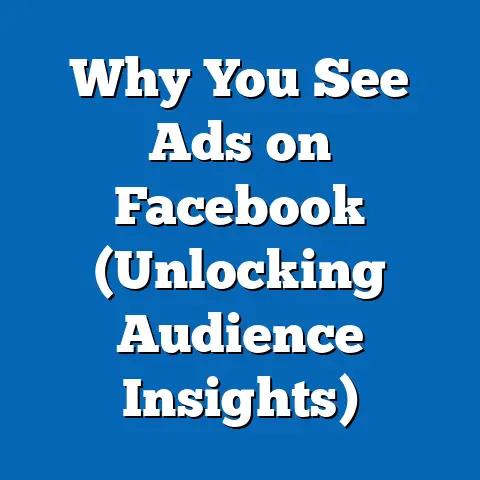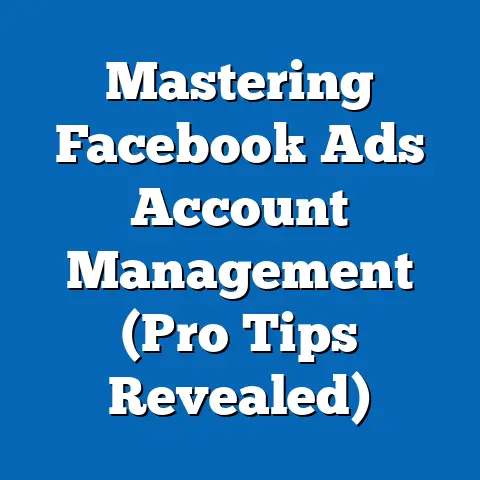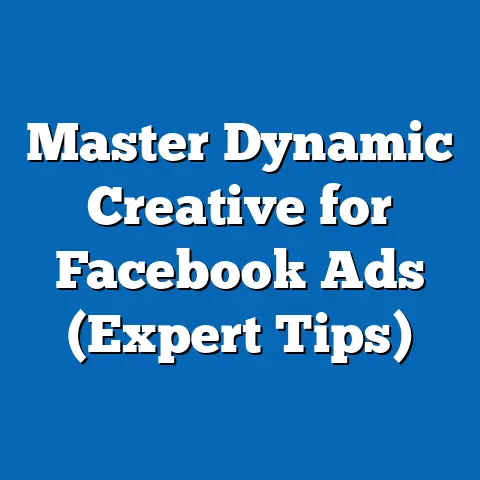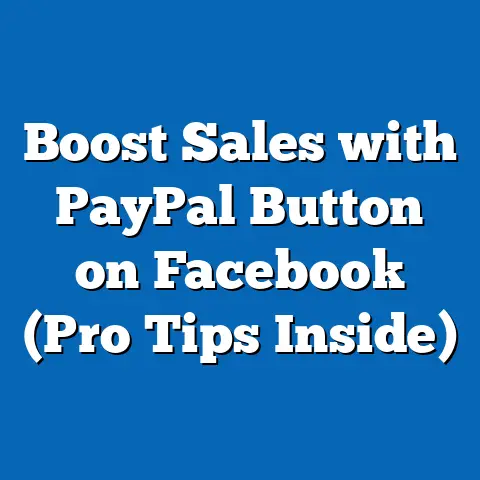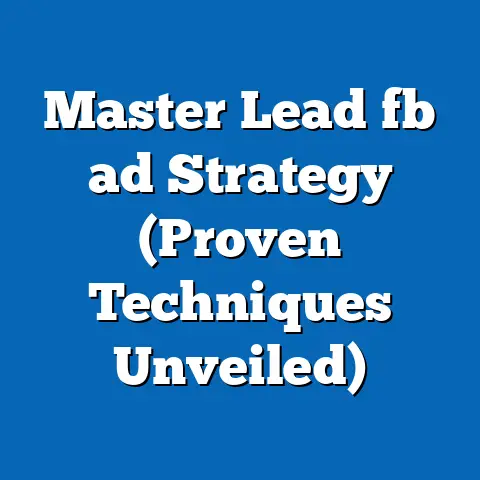Boost Facebook Ad CTR in 2025 (Proven Strategies)
Allergies are everywhere. It seems like every other person I meet these days is battling seasonal sniffles, food sensitivities, or some other kind of allergic reaction. These aren’t just minor inconveniences; they significantly impact people’s daily lives, influencing what they eat, where they go, and even what they buy.
This prevalence of allergies got me thinking about the world of digital marketing. Just as allergy sufferers are constantly searching for solutions to alleviate their symptoms, we marketers are always on the hunt for effective strategies to cut through the noise and grab the attention of our target audience. The digital landscape is just as crowded, if not more so, than a pollen-filled park in springtime. You need to stand out!
That’s where the Click-Through Rate (CTR) comes in. It’s the lifeblood of any successful Facebook advertising campaign. And in 2025, with the ever-evolving algorithms and user behaviors, mastering the art of boosting your CTR is more critical than ever. Let’s dive into some proven strategies that will help you capture attention, drive engagement, and ultimately, achieve your advertising goals.
Understanding Click-Through Rate (CTR) and Its Importance
So, what exactly is CTR? Simply put, Click-Through Rate is the percentage of people who see your ad and actually click on it. It’s calculated by dividing the number of clicks your ad receives by the number of times it’s shown (impressions), then multiplying by 100 to get a percentage.
CTR = (Total Clicks / Total Impressions) x 100
For example, if your ad is shown 1,000 times and gets 20 clicks, your CTR would be 2%.
Why is this number so important? Well, CTR is a direct indicator of how relevant and engaging your ad is to the audience you’re targeting. A higher CTR means your ad is resonating with people, capturing their interest, and prompting them to take action.
Think of it like this: you’re trying to sell lemonade on a hot summer day. A high CTR is like having a line of thirsty customers eagerly approaching your stand. A low CTR? That’s like watching people walk by without even glancing your way.
- Improved Ad Relevance Score: Facebook’s algorithm rewards ads with high CTRs by giving them a higher relevance score. This score affects how often your ad is shown and how much you pay for each impression.
- Lower Cost Per Click (CPC): A higher relevance score translates into lower CPC. Facebook essentially charges you less to show your ad because it recognizes that it’s providing value to its users.
- Increased Conversion Rates: When people click on your ad, they’re more likely to convert into customers. A compelling ad that resonates with the right audience will naturally lead to higher conversion rates and a better ROI.
- Enhanced Brand Awareness: Even if people don’t immediately convert, a high CTR means more people are seeing your brand and engaging with your message, contributing to increased brand awareness and recognition.
Key Takeaway: CTR is more than just a vanity metric. It’s a crucial indicator of your ad’s effectiveness and a key driver of campaign success.
The Evolving Landscape of Facebook Advertising in 2025
The world of Facebook advertising is constantly changing. What worked yesterday might not work today, and what works today might be obsolete tomorrow. As we move into 2025, it’s crucial to stay informed about the evolving landscape and adapt your strategies accordingly.
One of the biggest changes I’ve seen is the increasing sophistication of Facebook’s algorithm. It’s getting better and better at understanding user behavior, predicting their interests, and delivering relevant ads. This means that generic, one-size-fits-all ads are becoming less and less effective. Personalization is key.
Privacy regulations are also playing a significant role. With growing concerns about data privacy, Facebook is implementing stricter policies and giving users more control over their data. This makes it more challenging to target specific audiences and requires marketers to be more transparent about how they’re using data.
Emerging technologies like AI and machine learning are revolutionizing the way we approach ad targeting and personalization. AI-powered tools can analyze vast amounts of data to identify patterns and insights that would be impossible for humans to uncover. This allows marketers to create highly targeted and personalized ads that resonate with individual users on a deeper level.
Here are some specific trends and changes to be aware of in 2025:
- Increased Focus on Video: Video continues to dominate the digital landscape, and Facebook is no exception. Short-form video, in particular, is gaining popularity.
- Augmented Reality (AR) Ads: AR ads are becoming more mainstream, allowing users to interact with products in a virtual environment before making a purchase.
- AI-Powered Ad Creation: AI tools are making it easier to create compelling ad copy and visuals, even for those without extensive design or copywriting experience.
- Emphasis on Community and Connection: Facebook is prioritizing community and connection, so ads that focus on building relationships and fostering engagement are likely to perform well.
- Greater Transparency and Control: Users are demanding more transparency and control over their data, so marketers need to be upfront about how they’re using data and give users the option to opt out.
Key Takeaway: Staying ahead of these trends and changes is essential for ensuring the success of your Facebook ad campaigns in 2025. Embrace new technologies, adapt to evolving privacy regulations, and focus on creating personalized experiences that resonate with your target audience.
Here are some proven strategies that I’ve used and seen work to significantly boost Facebook Ad CTR in 2025:Strategy 1: Crafting Compelling Ad Copy
Your ad copy is your chance to make a first impression. It’s what grabs people’s attention and convinces them to click. So, how do you write compelling ad copy that resonates with your target audience?
- Know Your Audience: This is the most fundamental, yet often overlooked, aspect. Understand their pain points, desires, and motivations. What problems are they trying to solve? What are their aspirations? Use this knowledge to craft copy that speaks directly to their needs.
- Highlight the Benefits, Not Just the Features: Don’t just list the features of your product or service. Focus on the benefits it provides. How will it improve their lives? How will it make them feel?
- Use Strong Action Verbs: Start your headlines and call-to-actions with strong action verbs that encourage people to click. Examples include “Shop Now,” “Learn More,” “Get Started,” “Download Now,” and “Claim Your Offer.”
- Create a Sense of Urgency: Urgency motivates people to take action. Use words like “Limited Time Offer,” “Sale Ends Soon,” or “Don’t Miss Out” to create a sense of urgency.
- Keep it Concise and Clear: People have short attention spans. Get to the point quickly and use clear, concise language that’s easy to understand. Avoid jargon or technical terms that your audience might not be familiar with.
- Ask a Question: Posing a relevant question can pique people’s curiosity and encourage them to click to find the answer.
- Use Emojis Wisely: Emojis can add personality and visual appeal to your ad copy, but use them sparingly and make sure they’re relevant to your message.
Example of High-Performing Ad Copy:
Headline: Tired of feeling tired?
Body: Reclaim your energy and vitality with our all-natural supplement. Made with organic ingredients and clinically proven to boost energy levels.
Call to Action: Shop Now and get 20% off your first order!
Why it works: This ad copy speaks directly to the pain point of fatigue, highlights the benefits of the supplement (increased energy and vitality), and creates a sense of urgency with a limited-time discount.
Strategy 2: Eye-Catching Visuals and Formats
In a visually driven world, your ad’s visuals are just as important as your ad copy. They’re what initially grab people’s attention and make them stop scrolling.
- Use High-Quality Images and Videos: This seems obvious, but it’s worth repeating. Use images and videos that are clear, sharp, and visually appealing. Avoid blurry or pixelated images.
- Choose Relevant and Engaging Visuals: Your visuals should be relevant to your ad copy and your target audience. They should also be engaging and visually interesting.
- Experiment with Different Formats: Facebook offers a variety of ad formats, including single image ads, video ads, carousel ads, and collection ads. Experiment with different formats to see what works best for your audience.
- Use Bright Colors and Bold Designs: Bright colors and bold designs can help your ad stand out in a crowded newsfeed.
- Consider Using Motion Graphics or Animation: Motion graphics and animation can be highly engaging and can help you tell a story in a short amount of time.
- A/B Test Your Visuals: Just like with your ad copy, it’s important to A/B test your visuals to see what resonates best with your audience.
Here’s a breakdown of some popular Facebook ad formats:
- Single Image Ads: These are simple and effective, especially when you have a compelling image that speaks for itself.
- Video Ads: Video ads are highly engaging and can be used to tell a story, demonstrate a product, or share a testimonial.
- Carousel Ads: Carousel ads allow you to showcase multiple images or videos in a single ad. This format is great for highlighting different features of a product or service.
- Collection Ads: Collection ads are designed to showcase a collection of products in a visually appealing way. This format is ideal for e-commerce businesses.
- Instant Experience Ads: These are full-screen ads that load instantly when someone clicks on your ad. They provide a more immersive and engaging experience.
Strategy 3: Targeting the Right Audience
You could have the most compelling ad copy and eye-catching visuals in the world, but if you’re showing it to the wrong audience, it’s not going to generate results. Targeting the right audience is crucial for maximizing CTR and achieving your advertising goals.
- Define Your Ideal Customer: Before you start targeting, take the time to define your ideal customer. What are their demographics? What are their interests? What are their behaviors?
- Use Facebook’s Targeting Options: Facebook offers a wide range of targeting options, including demographic targeting, interest-based targeting, behavioral targeting, and custom audiences.
- Create Custom Audiences: Custom audiences allow you to target people who have already interacted with your business, such as website visitors, email subscribers, or customers.
- Use Lookalike Audiences: Lookalike audiences allow you to target people who are similar to your existing customers. This is a great way to expand your reach and find new customers.
- Experiment with Different Targeting Options: Don’t be afraid to experiment with different targeting options to see what works best for your audience.
- Monitor Your Results and Refine Your Targeting: Keep a close eye on your results and refine your targeting based on what you’re learning.
Here are some advanced targeting options available on Facebook:
- Detailed Targeting: This allows you to target people based on their interests, behaviors, demographics, and more.
- Custom Audiences from Your Website: You can create a custom audience of people who have visited specific pages on your website.
- Custom Audiences from Your Email List: You can upload your email list to Facebook and create a custom audience of your subscribers.
- Custom Audiences from Your App: If you have a mobile app, you can create a custom audience of your app users.
- Lookalike Audiences Based on Your Custom Audiences: You can create a lookalike audience based on your custom audiences to reach people who are similar to your existing customers.
Strategy 4: A/B Testing and Continuous Optimization
A/B testing, also known as split testing, is the process of comparing two versions of an ad to see which one performs better. This is an essential part of optimizing your Facebook ad campaigns and maximizing CTR.
- Test One Variable at a Time: When A/B testing, it’s important to test only one variable at a time. This allows you to isolate the impact of that variable and determine what’s working and what’s not.
- Test Your Headlines, Ad Copy, Visuals, and Call-to-Actions: These are all key elements of your ad that can have a significant impact on CTR.
- Use Facebook’s A/B Testing Tool: Facebook offers a built-in A/B testing tool that makes it easy to create and run A/B tests.
- Analyze Your Results and Make Data-Driven Decisions: Once your A/B test is complete, analyze the results and make data-driven decisions about which ad variation to use.
- Continuously Optimize Your Campaigns: A/B testing is an ongoing process. Continuously test and optimize your campaigns to improve performance over time.
Here’s how to set up an A/B test in Facebook Ads Manager:
- Go to Ads Manager.
- Create a new campaign or select an existing campaign.
- Choose your campaign objective.
- At the ad set level, turn on the “Create Split Test” option.
- Choose the variable you want to test (e.g., creative, audience, placement).
- Create two versions of your ad, each with a different variation of the variable you’re testing.
- Set your budget and schedule.
- Launch your A/B test.
Strategy 5: Leveraging User-Generated Content (UGC)
User-generated content (UGC) is any content created by your customers or fans, such as reviews, testimonials, photos, and videos. Incorporating UGC into your Facebook ads can be a powerful way to boost engagement and CTR.
- Authenticity and Trust: UGC is seen as more authentic and trustworthy than traditional advertising. People are more likely to trust the opinions of their peers than they are to trust the claims of a company.
- Increased Engagement: UGC can be highly engaging and can encourage people to interact with your brand.
- Cost-Effective: UGC is often free or low-cost.
- Social Proof: UGC provides social proof that your products or services are valuable and that other people are happy with them.
Here are some ways to incorporate UGC into your Facebook ads:
- Share Customer Reviews and Testimonials: Highlight positive reviews and testimonials in your ad copy or visuals.
- Feature Customer Photos and Videos: Ask your customers to share photos and videos of themselves using your products or services, and feature them in your ads.
- Run Contests and Giveaways: Encourage your customers to create content related to your brand by running contests and giveaways.
- Create a Dedicated Hashtag: Create a dedicated hashtag for your brand and encourage your customers to use it when sharing content on social media.
Key Takeaway: UGC is a powerful tool for boosting engagement and CTR. By incorporating authentic and relatable content created by your customers, you can build trust, increase engagement, and drive conversions.
Case Studies of Successful Facebook Ad Campaigns
Let’s take a look at a few examples of brands that have successfully increased their CTR through innovative strategies:
Case Study 1: A Clothing Retailer Using Carousel Ads with UGC
- Challenge: Low CTR and engagement with traditional single-image ads.
- Solution: Implemented carousel ads showcasing customers wearing their clothing. Each carousel card featured a customer photo, a short testimonial, and a link to purchase the featured item.
- Results: CTR increased by 150%, and conversion rates improved by 80%.
- Key Takeaway: Showcasing real people wearing your products can significantly boost engagement and drive sales.
Case Study 2: A Fitness App Using Video Ads with Personalized Messaging
- Challenge: Difficulty reaching new users and achieving a high click-through rate.
- Solution: Created a series of video ads that were personalized based on user interests and fitness goals. The ads featured short workout routines and highlighted the app’s key features.
- Results: CTR increased by 200%, and app downloads increased by 120%.
- Key Takeaway: Personalizing your ad messaging based on user interests can significantly improve engagement and drive conversions.
Case Study 3: A Local Restaurant Using Location-Based Targeting and Limited-Time Offers
- Challenge: Difficulty attracting local customers and competing with larger chain restaurants.
- Solution: Implemented location-based targeting to reach people within a 5-mile radius of their restaurant. The ads featured limited-time offers and highlighted the restaurant’s unique dishes.
- Results: CTR increased by 100%, and foot traffic to the restaurant increased by 75%.
- Key Takeaway: Location-based targeting and limited-time offers can be highly effective for attracting local customers.
Key Takeaway: These case studies demonstrate the power of innovative strategies and the importance of adapting to changes in the digital marketing landscape. By experimenting with different approaches and analyzing your results, you can find what works best for your business and achieve your advertising goals.
Conclusion
Boosting your Facebook ad CTR in 2025 requires a combination of creativity, data analysis, and a willingness to adapt to changes in the digital marketing landscape. By crafting compelling ad copy, using eye-catching visuals, targeting the right audience, A/B testing your ads, and leveraging user-generated content, you can significantly improve your CTR and achieve your advertising goals.
Remember, the key is to stay informed, experiment with different strategies, and continuously optimize your campaigns based on what you’re learning. The world of Facebook advertising is constantly evolving, so it’s important to be agile and adapt to changes as they come.
Now go out there and start implementing these proven strategies to enhance your Facebook ad campaigns and achieve higher CTR! The results will speak for themselves. Good luck!


